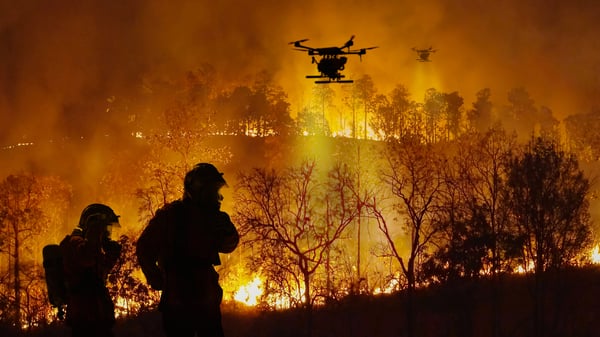
The challenge of protecting lives, ecosystems, and communities from wildfires has never been greater. With 70,000 wildfires in the U.S. each year, traditional firefighting methods, while essential, are often overwhelmed by the scale and speed of today’s fires. In response, innovative technologies are emerging to transform how we predict, detect, and combat wildfires.
As one of the most destructive forces on Earth, the impact of wildfires extends far beyond the burn zone. For communities, the consequences can be heartbreaking. Homes and businesses are reduced to ash, families are displaced, and lives are lost. Environmentally, wildfires destroy forests and wildlife habitats. The growing severity of these impacts underscores the urgent need for smarter, faster, and more effective wildfire management strategies.
Wildfire Prediction
Artificial Intelligence (AI)
While preventing wildfires from happening is the ultimate goal, being able to predict where and when they may start is the next best course of action. Current weather conditions such as temperature, humidity, and wind are actively monitored. AI algorithms use this information, combined with algorithms trained on historical wildfire data, to pinpoint when conditions are prime for wildfires in a certain area, and the path they may take. This information gives firefighters the opportunity to develop a proactive response using traditional methods and the evolving technology at their disposal.

Forest fire in Red Pines Forest; Photo courtesy of iStock, AegeanBlue
Early Detection Systems
Satellite technology, sensor networks, and drones all play important roles in the early detection of wildfires.
Satellite Technology
High-resolution images from satellites provide real-time monitoring of remote and inaccessible areas. This information allows for rapid updates on fire location, size, and spread. The data from these satellites can also be utilized to develop predictive models benefitting the AI systems mentioned above.
Sensor Networks
Placed in high-risk areas, these sensors combine optical cameras, thermal imaging, and gas detectors to collect and distribute information. CO2 levels, sudden temperature spikes, and air particulates associated with wildfires are monitored and compared to baseline levels. If the sensors detect elements found in wildfire conditions, geographically targeted notifications and warnings can be distributed for awareness and action.
 Firefighting drones help control wildfires; Photo courtesy of iStock, Toa55
Firefighting drones help control wildfires; Photo courtesy of iStock, Toa55
Drones
Whether they are controlled remotely or autonomous, drones have proven to be an effective method of wildfire detection. Equipped with infrared cameras for thermal detection and optical imaging capabilities for visual confirmation, drones can monitor fires safely from a distance without the traditional limitations imposed by rugged terrain. Drones are also helpful for identifying spot fires, which are new fires started in a different area from wind-carried embers.
Mitigation and Response
Datacasting
When it comes to sharing information about wildfires, time is of the essence. Using existing digital television signals, time-sensitive and targeted information can be sent to specific receivers such as emergency responders. Datacasting allows large files, including video content, to be sent to provide the most up-to-date and detailed information needed to take action. This tactic bypasses traditional cellular networks which are commonly congested during a crisis.
Edge Computing
Traditional computing collects data from various devices and sends the information to a central data center for processing. Edge computing, however, reduces latency by bringing the processing power closer to the source. For wildfire field units, this provides immediate insights for quick decision making when lives and property are at risk. One example of edge computing is the WIFIRE EDGE platform developed by The Department of Homeland Security (DHS) Science and Technology Directorate (S&T). The platform leverages weather satellite imagery and sensor data to create a model for first responders and fire professionals to analyze and use in their action plans.
Dixon Forestry Fire Products
At Dixon, we understand how critical it is to be prepared for a wildfire. We offer a variety of forestry products in stock and ready to ship from our nationwide distribution centers.
Forestry Fire Hose Non-Weeping
- Single jacket lined attack hose
- Standard yellow color
- Made in the USA
- Available in 50’ and 100’ lengths
- Other lengths available upon request, contact Dixon
Specifications
- Temperature range: -60°F to 112°F (-51°C to 44°C)
- Burst pressure: 900 PSI at ambient temperature 70°F (21°C)
- Service test pressure: 600 PSI at ambient temperature 70°F (21°C)
- Working pressure: 300 PSI at ambient temperature 70°F (21°C)
Features
- Coupled with female and male brass ferrule type garden hose couplings
- Impregnation: yellow
- Consult Dixon for pricing and availability of other threads and configurations
Specifications
- Proof pressure: 300 PSI at ambient temperature 70°F (21°C)
- Service test pressure: 150 PSI at ambient temperature 70°F (21°C)
- Working pressure: 135 PSI at ambient temperature 70°F (21°C)
Forestry Grade Aluminum Ball Shut-Off Valve
- Hard coated threads, acetal ball, and rigid inlet
Specifications
- Maximum operating pressure: 600 PSI at ambient temperature 70°F (21°C)
- Forest Service Spec 5100-238
- Maroon hard-coated barrel allows for easy identification
- Corrosion resistant plated
- Dual flow rate nozzles offer two straight stream and two fog patterns
Specifications
- Maximum operating pressure: 600 PSI (water only) at 70°F (21°C)
- Forest Service Spec 5100-239
Feature
- Adjustable gallons per minute to allow firefighters to control the amount of water coming from the nozzle
Specifications
- Straight: 61 GPM at 100 PSI
- Fog: 105 GPM at 100 PSI
- Straight stream, capable of greater than 100° of spray angle
- Twist shut-off and flow-type change
Specifications
- Maximum working pressure: 100 PSI
- Maximum rated pressure: 175 PSI
- Axe blade for cutting
- Pick for prying
Specification
- 36” hickory handle
Forged Forestry Couplings: Male and Female
Feature
- Common quarter-turn sexless head (a 1-1/2” QT fitting will mate with a 3/4” QT or 1” QT)
Specification
- Maximum operating pressure: 300 PSI at ambient temperature 70°F (21°C)
Quick Connect Forestry Expansion Ring Couplings
- 1-11/16” bowl size forged aluminum construction
Specification
- Sold in sets of (2) with expansion ring
Forestry Hose Clamp and Spanner
- Offset handle enables the user to easily operate the clamp while wearing gloves
- When clamped onto the hose the brass device safely holds the clamp in position, a spanner is an integral part of the clamp
Specifications
- To be used with lightweight 1” and 1-1/2” hoses for pressures up to 200 PSI
- Forest Service Spec 5100-245
Summary
It is important to understand the causes of wildfires in an attempt to prevent them, but that is merely the first step. New technology must continue to be adopted to predict, detect, and respond to the increasing number of wildfires. By leveraging the power of AI, sensors, satellites, drones, datacasting, and edge computing, the assessment and mitigation of these calamities can be conducted more efficiently, reducing the potential impact on the community and the environment.
For more information, visit dixonvalve.com or call 877.963.4966.












